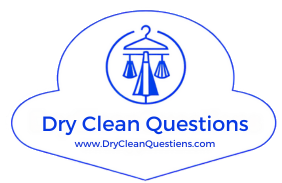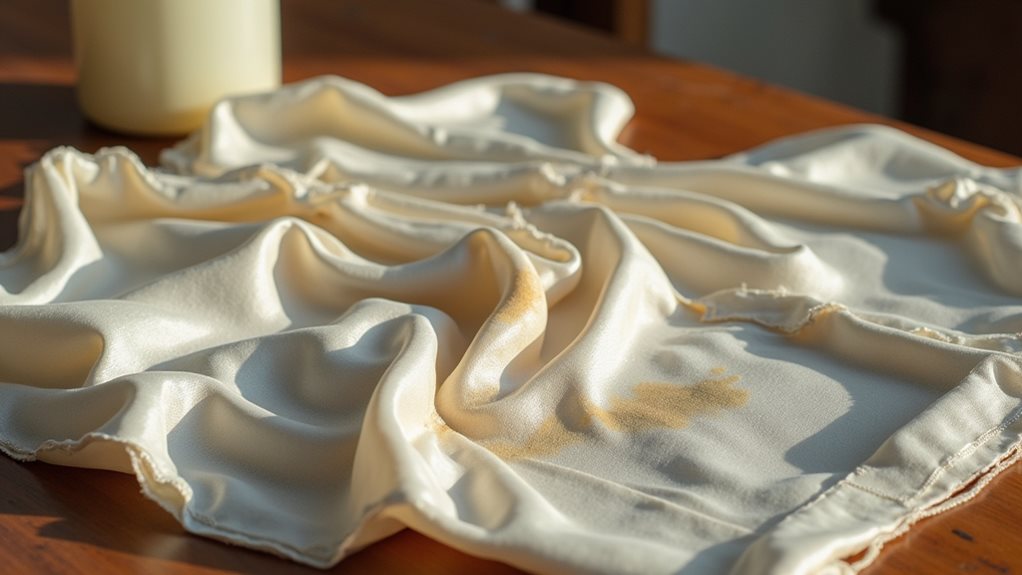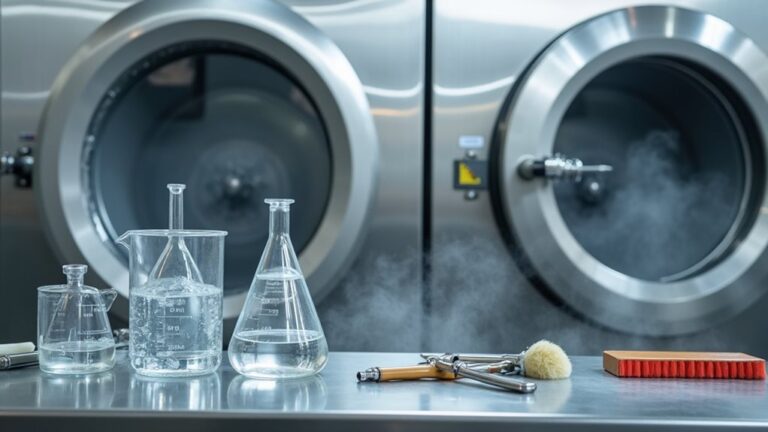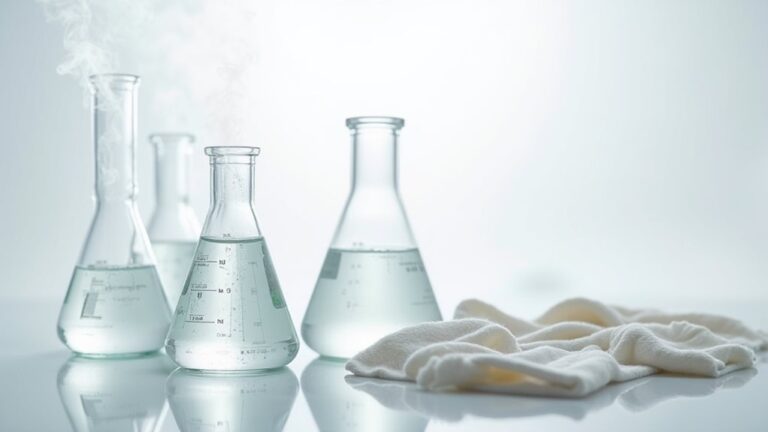You’ll face several drawbacks when dry cleaning your clothes, starting with exposure to PERC, a probable carcinogen that can cause headaches and respiratory issues. The process costs $10-30 per piece, adding up quickly for your wardrobe, while chemical solvents gradually weaken delicate fibers and fade colors over time. Frustratingly, dry cleaning can’t remove water-soluble stains like sweat or blood, and you’re stuck waiting 2-3 days for service—there’s much more to reflect upon.
Health Risks of Chemical Solvents
When I first learned that perchloroethylene, the chemical solvent powering most dry cleaning operations, carries a “probable carcinogen” label from international health experts, I’ll admit I felt a bit foolish for never questioning what exactly was cleaning my favorite blazer all these years 😅.
The health risks of these chemical solvents extend far beyond cancer concerns, though that’s certainly unsettling enough. Prolonged exposure can trigger neurological symptoms like dizziness, headaches, and cognitive issues that you mightn’t immediately connect to your freshly pressed shirts.
Direct contact with hazardous solvents causes skin, eye, and respiratory irritation, while residual chemicals can linger in your garments long after pickup, meaning you’re potentially breathing in these substances every time you wear that “clean” outfit.
While brief, occasional exposure to dry cleaned garments is generally considered low-risk for consumers, dry cleaning workers face significantly higher exposure levels and greater health risks due to their daily contact with these chemical solvents.
Environmental Impact and Pollution Concerns
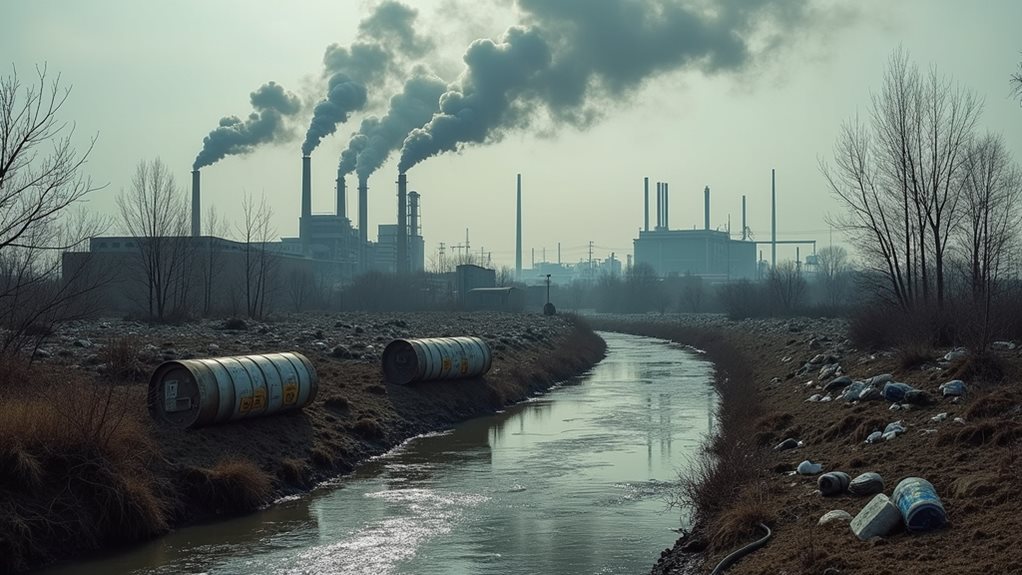
While the health risks of dry cleaning chemicals are troubling enough, the environmental impact these same solvents inflict on our planet creates a ripple effect that extends far beyond any individual’s wardrobe concerns.
When you choose traditional dry cleaning, you’re unknowingly contributing to a process where roughly 85% of perchloroethylene (PERC) escapes into the atmosphere, greatly worsening air pollution in your community.
These hazardous chemicals don’t just disappear—they seep into groundwater sources that your neighbors rely on for drinking water, creating cleanup nightmares that can last decades.
The soil pollution from improper disposal of cleaning agents affects local ecosystems, while your property values might even drop if you live near these facilities.
Fortunately, many dry cleaners are transitioning to safer alternatives like liquid CO2 or hydrocarbon solvents to reduce these environmental impacts.
It’s honestly heartbreaking how our quest for wrinkle-free clothes comes at such an environmental cost.
High Costs and Financial Burden

You’ll quickly discover that dry cleaning hits your wallet harder than you might expect, especially when you consider the specialized equipment costs that shops must invest in just to handle your delicate fabrics properly.
The chemical solvents themselves aren’t cheap either – we’re talking about expensive, industrial-grade solutions that need constant replenishing, and guess who ultimately pays for that ongoing expense? 💸
When you add up the overhead from these fancy machines and pricey chemicals, it’s no wonder that simple garment cleaning can cost you anywhere from $10 to $30 per piece, making your monthly clothing care budget feel like a small mortgage payment.
Beyond equipment and chemicals, dry cleaners face substantial labor expenses since each garment requires hand-pressing and meticulous individual attention that automated processes simply can’t provide.
Specialized Equipment Costs
The financial reality of dry cleaning hits differently when you’re standing at the counter, watching your weekly clothing budget evaporate faster than acetone in summer heat.
Those dry cleaning services you’ve been relying on aren’t just charging for convenience—they’re passing along massive equipment costs that’ll make your wallet weep.
The specialized equipment required for handling hazardous chemical solvents costs more than most people’s cars, and that’s before factoring in maintenance, skilled labor training, and safety protocols.
When you add stain removal services and pressing, you’re looking at an overall financial burden that compounds into serious long-term costs, especially when frequent exposure leads to garment deterioration.
Business owners also face significantly higher insurance premiums due to the risks associated with chemical handling and storage.
- Industrial dry cleaning machines cost $50,000-$200,000 each
- Monthly solvent expenses can reach thousands of dollars
- Specialized ventilation systems require constant maintenance
- Skilled technicians demand higher wages than regular laundry workers
Chemical Solvent Expenses
Because chemical solvents represent the lifeblood of dry cleaning operations, their astronomical costs trickle down to you like an unwelcome surprise on every receipt.
These hazardous chemicals don’t come cheap, and unlike the biodegradable detergents you can grab for five bucks at your local store, professional solvents require specialized handling, storage, and disposal protocols that inflate expenses dramatically.
You’re fundamentally paying for a complex chemical dance that your dry cleaning services must perform with every garment, creating a financial burden that compounds over time.
What’s particularly frustrating is the long-term costs associated with garment deterioration from repeated chemical exposure, meaning you’ll face the double whammy of expensive cleaning fees plus premature replacement costs when your favorite pieces inevitably break down from harsh solvent treatments.
The most commonly used solvent, perchloroethylene (PERC), requires extensive safety measures and proper ventilation systems that further drive up operational costs for dry cleaning businesses.
Potential for Fabric Damage Over Time

While your favorite silk blouse might look pristine after its first few trips to the dry cleaner, those harsh chemical solvents are quietly working behind the scenes, weakening the delicate fibers with each treatment like a slow, invisible erosion.
Dry cleaning can cause serious fabric damage that you won’t notice until it’s too late, turning your investment pieces into expensive regrets.
Here’s how chemical treatment gradually destroys your clothes:
- Fiber weakening – Delicate fabrics like cashmere lose their structural integrity, becoming thin and fragile.
- Dimensional changes – Your perfectly-fitted blazer might shrink or stretch beyond recognition.
- Color degradation – Vibrant hues fade into disappointing shadows of their former selves.
- Embellishment loss – Embellished fabrics suffer bead or sequin damage, ruining intricate designs.
This cumulative damage forces premature replacement, making dry cleaning counterproductive for preserving your wardrobe’s longevity. The primary culprit behind this fabric deterioration is perchloroethylene (PERC), the most commonly used solvent in traditional dry cleaning that acts as a harsh chemical agent on textile fibers.
Ineffectiveness on Certain Stains and Odors
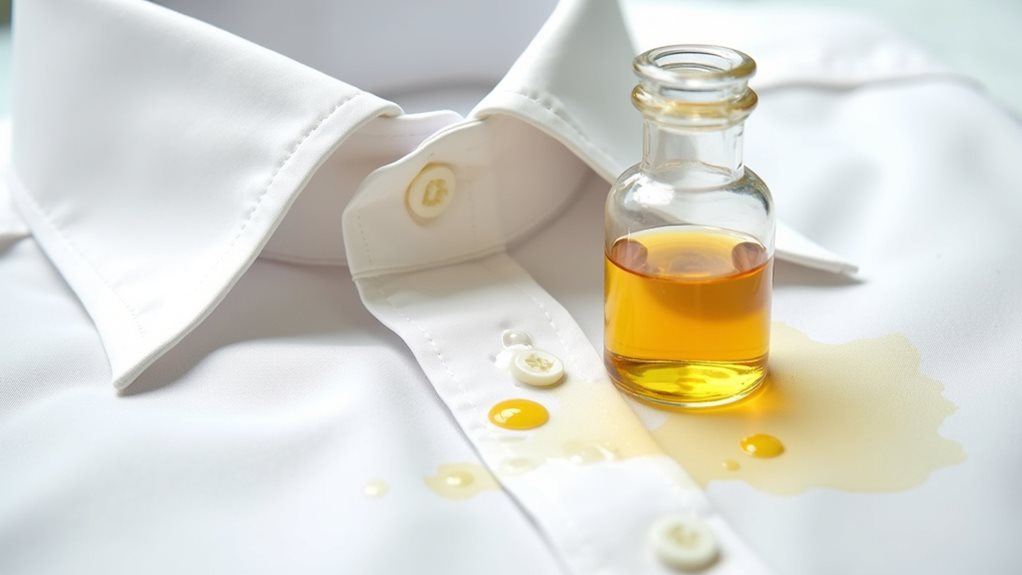
Despite spending top dollar on professional dry cleaning, you’ll discover that some stains laugh in the face of those fancy chemical solvents, stubbornly clinging to your favorite garments like unwelcome house guests who refuse to leave.
The ineffectiveness becomes painfully obvious when that red wine mishap from last month’s dinner party remains as a permanent reminder, or when your heavily soiled work clothes emerge looking disappointingly unchanged.
Water-soluble stains particularly resist dry cleaning’s chemical approach, often requiring traditional washing methods instead.
Water-based stains mock dry cleaning’s expensive solvents, demanding old-fashioned soap and water to actually disappear from your clothes.
Common culprits include sweat stains, blood, and certain beverages that simply don’t respond well to the solvent-based cleaning process.
You’ll also notice lingering odors that somehow survive the entire process, making you wonder if alternative cleaning methods might’ve been smarter choices.
Sometimes the most expensive solution isn’t the most effective one!
Inconvenience of Professional Service Dependency

Beyond the frustration of persistent stains, you’ll quickly realize that dry cleaning chains you to someone else’s schedule, transforming what should be a simple clothing care routine into a complex logistical puzzle that’d make a military strategist weep.
Professional services often have limited availability during peak times, creating wardrobe delays when you desperately need that blazer for tomorrow’s meeting.
The dependency on dry cleaning services means you’re constantly juggling turnaround times, which can stretch for days, leaving you outfit-less and stressed. Finding consistent quality of service becomes another headache entirely.
Most standard dry cleaning services require 2-3 business days to complete the cleaning process, which means you must plan your wardrobe needs well in advance or face the inconvenience of being without essential garments.
Consider these scheduling nightmares:
- Racing to drop off bulky items before closing time
- Waiting weeks for your favorite coat during busy seasons
- Paying premium rush fees when you forget to plan ahead
- Making multiple trips to transport garments, which becomes financially inconvenient
Limited Sustainability and Eco-Friendliness
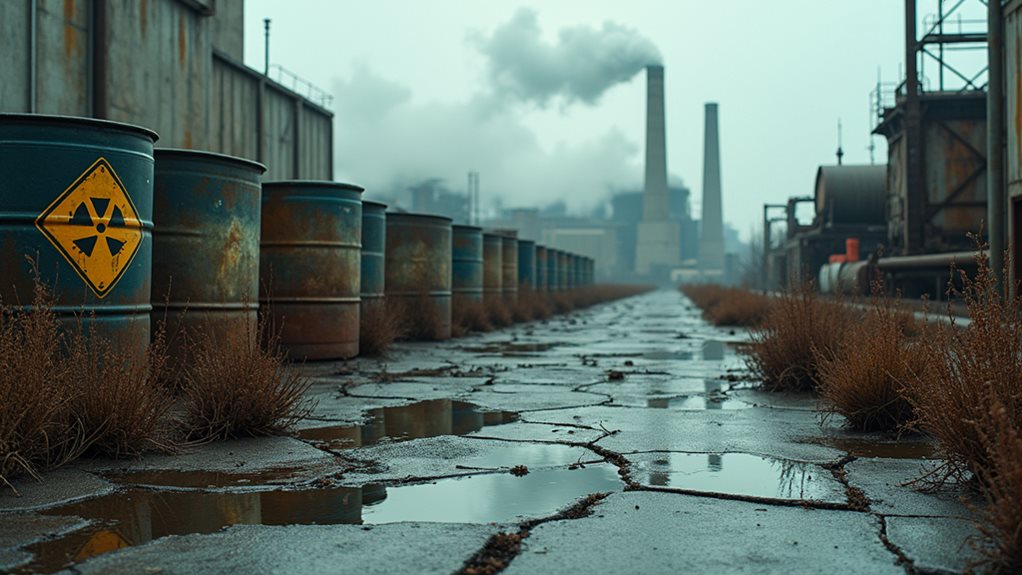
When you start digging into the environmental impact of dry cleaning, you’ll discover a troubling reality that most people never consider while dropping off their favorite blazer.
The traditional dry cleaning process relies heavily on perchloroethylene (PERC), a chemical that’s harmful to the environment and classified as a probable carcinogen – yikes! 😬 This creates serious health and environmental concerns that extend far beyond your freshly pressed shirt.
That favorite blazer might look spotless, but the cancer-causing chemicals used to clean it are seriously contaminating our planet.
The limited sustainability of conventional methods becomes glaringly obvious when you realize PERC contributes to massive air pollution, accounting for roughly 85% of emissions from dry cleaning operations.
Even worse, improper disposal leads to soil and groundwater contamination that persists for decades.
While eco-friendly alternatives like wet cleaning exist, most establishments still use these toxic chemicals, making truly sustainable garment care frustratingly elusive.
The health risks are particularly severe for dry cleaning workers who face prolonged exposure to PERC through daily inhalation and skin contact in their workplace environment.
